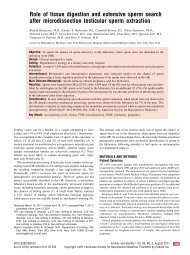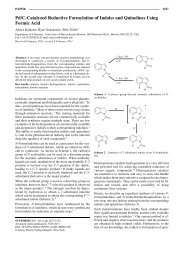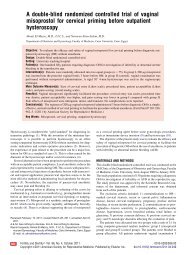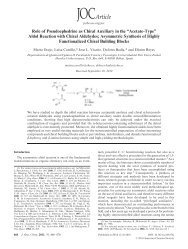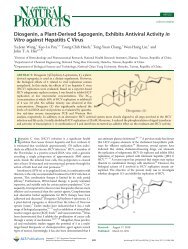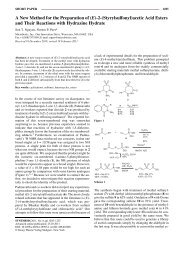Management of Recurrent Head and Neck Cancer
Management of Recurrent Head and Neck Cancer
Management of Recurrent Head and Neck Cancer
You also want an ePaper? Increase the reach of your titles
YUMPU automatically turns print PDFs into web optimized ePapers that Google loves.
TMPDAPV IN PPArTirc Drugs2on. 71 (12): 1551-1559<br />
InCKAri IrM rKA^II\.>E 0012-0607/11/0012-1561/S55.55/0<br />
© 2011 Adls Data Information BV. Ali rights reserved.<br />
<strong>Management</strong> <strong>of</strong> <strong>Recurrent</strong> <strong>Head</strong> <strong>and</strong><br />
<strong>Neck</strong> <strong>Cancer</strong><br />
Recent Progress <strong>and</strong> Future Directions<br />
Bruce E. Brockstein<br />
Hematology/Oncology, NorthShore University HealthSystem, Evanston, IL, USA<br />
Contents<br />
Abstract 1551<br />
1. <strong>Recurrent</strong> Squamous Carcinoma <strong>of</strong> the <strong>Head</strong> <strong>and</strong> <strong>Neck</strong> 1552<br />
2. Specific Agents 1555<br />
3. Single-Agent versus Combination Ttierapy 1555<br />
4. Biologically Targeted Therapies against Epidermal Growth Factor Receptor 1555<br />
5. Other Molecularly Targeted Therapies 1556<br />
6. Palliative Care Strategies 1557<br />
7. Conclusions 1558<br />
Abstract The incidence <strong>of</strong> squamous cell carcinoma <strong>of</strong> the head <strong>and</strong> neck (SCCHN)<br />
is on the rise in the US despite a drop in cigarette smoking rates. Much <strong>of</strong> this<br />
rise is due to the increasing incidence <strong>of</strong> SCCHN attributable to human papillomavirus<br />
(HPV). HPV-related SCCHN has a high cure rate, which contributes<br />
to the stable death rates despite the increased incidence. Up to half <strong>of</strong><br />
patients with SCCHN will develop recurrence. For these patients, the first<br />
clinical decision is whether the recurrence is potentially treatable for cure, or<br />
is incurable. For those deemed potentially curable, surgical or radiationbased<br />
therapies, or both, are undertaken. For those who have incurable recurrences,<br />
the goals are palliation <strong>and</strong> possibly prolongation <strong>of</strong> life - average<br />
survivals are in the range <strong>of</strong> 6-12 months depending on the type <strong>of</strong> recurrence<br />
<strong>and</strong> other factors.<br />
Several chemotherapy drugs are active in SCCHN, most notably the platinum<br />
compounds, taxanes, fluorouracil (5-FU), methotrexate <strong>and</strong> cetuximab.<br />
Approximately 10-25% <strong>of</strong> patients will respond to treatment with one<br />
<strong>of</strong> these drugs. The response rate is higher for combinations such as a platinum<br />
plus a taxane, a platinum plus 5-FU, a combination <strong>of</strong> the three, or one<br />
<strong>of</strong> more <strong>of</strong> these drugs plus cetuximab. Combination chemotherapy has not<br />
been shown to prolong survival over single-agent therapy, with the exception<br />
<strong>of</strong> the addition <strong>of</strong> cetuximab to a platinum <strong>and</strong> 5-FU combination. A number<br />
<strong>of</strong> orally bioavailable tyrosine kinase inhibitors have been tested or are undergoing<br />
trials in SCCHN. None <strong>of</strong> these has as yet been shown to be more<br />
effective than the currently available drugs. For patients with recurrences<br />
who are undergoing active therapy, <strong>and</strong> especially for those for whom further
1552 Brockstein<br />
American <strong>Cancer</strong> Society figures indicated an<br />
expected 49 260 cases <strong>of</strong> squamous cell carcinoma<br />
<strong>of</strong> the head <strong>and</strong> neck (SCCHN) involving the oral<br />
cavity pharynx, <strong>and</strong> larynx in the US in 2010.''^<br />
This represents an increase over the past 10 years<br />
<strong>of</strong> approximately 9000 cases;'^^ much <strong>of</strong> this increase<br />
is attributable to an increase in the incidence<br />
<strong>of</strong> human papillomavirus (HPV)-related<br />
squamous cell carcinomas <strong>of</strong> the tonsil <strong>and</strong> base<br />
<strong>of</strong> tongue.'^l Thus, despite fewer smokers <strong>and</strong><br />
a decrease in the number <strong>of</strong> tobacco-related<br />
oropharyngeal cases,^'*' the number <strong>of</strong> cases is<br />
actually increasing. Whereas this represents the<br />
eighth or ninth most common malignancy in the<br />
US, in other parts <strong>of</strong> the world, SCCHN is an<br />
even bigger problem. Worldwide, these exact<br />
numbers are harder to ascertain. In that same<br />
10-year period from 2000 to 2010, death rates in<br />
the US are steady at an expected 11 500, representing<br />
about a 75% 'cure' rate. Death rates may<br />
be even higher though, as we know that cure rates<br />
for the two-thirds <strong>of</strong> patients presenting with<br />
locoregionally advanced disease are only in the<br />
range <strong>of</strong> 30-60%. Some <strong>of</strong> these patients with<br />
recurrences may be recorded as having died <strong>of</strong><br />
noncancer-related causes, although some may be<br />
direct or indirect: complications <strong>of</strong> the cancer or<br />
its therapy. In addition, many patients without<br />
recurrences die in a period <strong>of</strong> 5-10 years from<br />
co-morbidities that correlate with head <strong>and</strong> neck<br />
cancer.t'f These include cardiovascular disease<br />
from smoking, pulmonary disease from smoking,<br />
alcohol-related liver problems, <strong>and</strong> other tobacco<strong>and</strong><br />
alcohol-related malignancies, which result in<br />
the death <strong>of</strong> many <strong>of</strong> these patients in a 5-10 year<br />
period while, they are free <strong>of</strong> cancer. Therefore,<br />
although the numbers are hard to ascertain exactly,<br />
<strong>of</strong> the 49 000 patients with head <strong>and</strong> neck<br />
cancer in the US, up to half may at some point<br />
develop a recurrence <strong>of</strong> their SCCHN in a 5-year<br />
period, or die <strong>of</strong> late cancer or treatment-related<br />
complications.<br />
therapy is no longer appropriate or is declined, strict attention is necessary to<br />
palliation <strong>of</strong> pain, oral <strong>and</strong> airway issues, <strong>and</strong> to nutrition, speech, <strong>and</strong> social<br />
<strong>and</strong> psychological issues.<br />
The 'st<strong>and</strong>ard' treatment for SCCHN is dependent<br />
upon numerous factors. Early stage<br />
(I-II) SCCHN is typically treated by surgery or<br />
radiation with approximately equivalent cure<br />
rates. The choice <strong>of</strong> modality depends upon the<br />
expected morbidities <strong>of</strong> each treatment, patient<br />
co-morbidities, available expertise <strong>and</strong> patient<br />
preferences. Patients with locoregionally advanced<br />
(stage III <strong>and</strong> IV) disease are generally<br />
treated with multi-modality therapy. Resectable<br />
oral cavity cancers are generally treated surgically<br />
with postoperative radiation with or without<br />
chemotherapy. In the pharynx <strong>and</strong> larynx,<br />
most locoregionally advanced head <strong>and</strong> neck<br />
cancers are treated with organ preservation intent<br />
with concomitant chemotherapy <strong>and</strong> radiation,<br />
with surgery used for residual disease in the neck<br />
or primary site, or for salvage.<br />
The challenges <strong>of</strong> treating these patients with<br />
recurrent disease, representing up to 50% <strong>of</strong> those<br />
initially diagnosed, are outlined in this review.<br />
PubMed was searched using the terms 'head <strong>and</strong><br />
neck cancer' linked with 'chemotherapy', 'tyrosine<br />
kinase inhibitors', 'reirradiation', 'chemotherapy'<br />
<strong>and</strong> 'r<strong>and</strong>omized trials'; in addition, all<br />
published abstracts from Proceedings <strong>of</strong> the<br />
American Society <strong>of</strong> Clinical Oncology (ASCO)<br />
from 2006-10 were searched.<br />
1. <strong>Recurrent</strong> Squamous Carcinoma <strong>of</strong> the<br />
<strong>Head</strong> <strong>and</strong> <strong>Neck</strong><br />
<strong>Recurrent</strong> SCCHN is <strong>of</strong>ten incurable; however,<br />
recurrent <strong>and</strong> incurable are not synonymous <strong>and</strong><br />
should not be confused. The first clinical question<br />
with any recurrence is to categorize the recurrence<br />
as one that is potentially salvageable for a<br />
cure, or one for which the goals are palliation <strong>and</strong><br />
prolongation <strong>of</strong> life.<br />
Isolated recurrences in the neck or primary site<br />
may be curable. This is most commonly encountered<br />
with isolated neck recurrences in ipsilateral or<br />
© 2011 Adis Data Information BV. All righfs reserved. Drugs 2011:71 (12)
<strong>Management</strong> <strong>of</strong> <strong>Recurrent</strong> <strong>Head</strong> <strong>and</strong> <strong>Neck</strong> <strong>Cancer</strong> 1553<br />
contralateral previously non-dissected necks.<br />
Recurrence in an un-irradiated neck may be<br />
treated for a cure with a first course <strong>of</strong> radiation<br />
or surgery plus radiation in some cases. Likewise,<br />
some primary site recurrences may be salvageable<br />
for cure. Perhaps most notable would be larynx<br />
recurrences in patients previously treated with<br />
organ preservation attempt by radiation with or<br />
without chemotherapy. Salvage laryngectomy in<br />
the setting <strong>of</strong> larynx-only recurrence results in<br />
cure rates <strong>of</strong> up to 50%.'^' Other subsites within<br />
the head <strong>and</strong> neck may be treated for cure<br />
with salvage surgery but with lower cure rates.<br />
Given the high recurrence rates, postoperative<br />
re-irradiation following salvage surgery has been<br />
used. However, one r<strong>and</strong>omized clinical trial has<br />
compared re-irradiation plus chemotherapy postsalvage<br />
surgery with no further therapy. In this<br />
study, there was a disease-free survival benefit for<br />
re-irradiation but no benefit for overall survival.t^'<br />
As with locoregional recurrence in the head<br />
<strong>and</strong> neck, identification <strong>of</strong> distant disease should<br />
first prompt the question on goal <strong>of</strong> therapy. For<br />
example, an isolated lesion in the lung may represent<br />
a second primary lung cancer, which if<br />
diagnosed as a small peripheral lesion may be<br />
treated with surgery with cure rates <strong>of</strong> up to 80%.<br />
There are additional data suggesting that resection<br />
<strong>of</strong> true isolated métastases in the lung, adrenal<br />
gl<strong>and</strong> or other organs may yield 5-year survival<br />
rates <strong>of</strong> 20%,'^ <strong>and</strong> therefore the goal <strong>of</strong> treatment<br />
may be cure, once other distant metastatic disease is<br />
excluded by proper radiological workup.<br />
Locoregional recurrent disease in an inoperable,<br />
previously irradiated field is generally incurable.<br />
An exception to this may be lower volume disease<br />
amenable to treatment with chemotherapy <strong>and</strong><br />
re-irradiation. Several clinical trials have demonstrated<br />
3- to 5-year disease-free rates <strong>of</strong> up to<br />
20% or 30%.t^"'°i Prognostic factors identified<br />
that correlate with increased locoregional control,<br />
progression-free survival or overall survival include<br />
lower tumour bulk at re-irradiation, higher<br />
re-irradiation treatment dose, tumour subsite<br />
(nasopharynx), lack <strong>of</strong> co-morbidities <strong>and</strong> organ<br />
dysfunction, longer interval since prior irradiation,<br />
use <strong>of</strong> intensity-modulated radiation therapy,<br />
<strong>and</strong> specific chemotherapy regimens.'^;'°1 In<br />
general, re-irradiation should only be undertaken<br />
in healthy patients without major co-morbidities<br />
<strong>and</strong> without major sequelae following their first<br />
course <strong>of</strong> radiotherapy.<br />
The remainder <strong>of</strong> this article focuses on those<br />
patients for whom curative therapy is not an available<br />
option. For those patients without an available<br />
curative attempt option, the goals <strong>of</strong> therapy<br />
should be clearly defined to the patient <strong>and</strong> those<br />
helping him or her to make decisions. Some patients<br />
may opt against potentially life-prolonging<br />
therapies given their interpretation <strong>of</strong> the risk <strong>and</strong><br />
benefit issues, <strong>and</strong> may opt for palliative or comfort<br />
care alone. This, too, poses many therapeutic<br />
challenges for these patients, as they are not being<br />
actively treated for their cancer but require significant<br />
multidisciplinary care <strong>and</strong> therapy for<br />
proper palliation <strong>of</strong> tumours that may cause pain<br />
<strong>and</strong> interfere significantly with eating, breathing,<br />
speaking <strong>and</strong> social functioning.<br />
It remains somewhat unproven as to whether<br />
systemic therapy for recurrent SCCHN provides<br />
an advantage in terms <strong>of</strong> duration <strong>of</strong> survival. Only<br />
one study, performed many years ago, compared<br />
chemotherapy with best supportive care, <strong>and</strong><br />
showed a small survival advantage,t"l Multiple<br />
r<strong>and</strong>omized clinical trials <strong>of</strong> single-agent chemotherapy<br />
versus combination chemotherapy (without<br />
a control arm <strong>of</strong> best supportive care) demonstrated<br />
no survival benefit (table I),t'^"'^l with overall<br />
survival durations <strong>of</strong> 6-8 months. In a study assessing<br />
two commonly used two-drug regimens,<br />
no survival difference was seen in a comparison<br />
<strong>of</strong> cisplatin <strong>and</strong> infusional fluorouracil (5-FU)<br />
versus the combination <strong>of</strong> cisplatin <strong>and</strong> taxol,''^'<br />
Modern, multi-agent aggressive chemotherapy<br />
regimens result in median survival durations <strong>of</strong><br />
10-12 months,''^'^^! Lead time bias, associated with<br />
more intensive <strong>and</strong> sensitive radiological monitoring,<br />
however, may artificially inflate survival<br />
numbers now, as recurrent disease is <strong>of</strong>ten discovered<br />
at an earlier time in the natural history <strong>of</strong><br />
the recurrent disease process. Only one.study, the<br />
recent EXTREME (Erbitux in First-Line Treatment<br />
<strong>of</strong> <strong>Recurrent</strong> or Metastatic <strong>Head</strong> <strong>and</strong> <strong>Neck</strong><br />
<strong>Cancer</strong>) trial,P^l has shown an advantage for one<br />
chemotherapy regimen over another. In this trial,<br />
442 patients were r<strong>and</strong>omly assigned to receive<br />
© 2011 Adis Data informotion BV. Aii rights reserved. Drugs 2011; 71 (12)
1554 Brockstein<br />
Table I. R<strong>and</strong>omized trials comparing drug combinations with single agents or comparing drug combinations<br />
study Regimen<br />
SWOGI'21 Cis/5-FU<br />
Carbo/5-FU<br />
MTX<br />
Jacobs et al.'^^' Cis/5-FU<br />
Cis<br />
5-FU<br />
LHNOGl^"! Cis/5-FU<br />
Cis/MTX<br />
Cis<br />
MTX<br />
EORTC'^^1 Cis/5-FU<br />
Cis/MTX/Bleo/V<br />
Cis<br />
SECSG'^^i Cis/Vinbl/Bleo<br />
MTX<br />
ECOG'^'l Cis/MTX/Bleo<br />
MTX<br />
ECOGI'^I Cis/5-FU<br />
No. <strong>of</strong> patients<br />
87<br />
86<br />
88<br />
79<br />
83<br />
83<br />
50<br />
50<br />
50<br />
50<br />
116<br />
127<br />
122<br />
92<br />
98<br />
80<br />
83<br />
98<br />
Response rate (%)<br />
Cis/Taxol<br />
96<br />
28<br />
9<br />
5-FU=fluorouracil; Bleo=bleomycin; Carbo=carboplatin; Ci9=cisplatin; ECOG = Eastem Cooperative Oncology Group; EORTC=European<br />
Organization for the Research <strong>and</strong> Treatment <strong>of</strong> <strong>Cancer</strong>; LHNOG = Liverpool <strong>Head</strong> <strong>and</strong> <strong>Neck</strong> Oncology Group; MTX=methotrexate;<br />
SECSG = Southeastern <strong>Cancer</strong> Study Group; SWOG = Southwest Oncology Group; Taxol = paclitaxel; V=vincristine; Vlnbl = vinblastin8.<br />
infusional 5-FU plus cisplatin or carboplatin <strong>and</strong><br />
weekly cetuximab, or the same chemotherapy<br />
without cetuximab. Chemotherapy was limited to<br />
six cycles, but cetuximab could be continued. The<br />
median survival significantly favoured the cetuximab<br />
arm, 10.1 versus 7.4 months (ha¿ard<br />
ratio [HR] 0.80; 95% CI 0.64, 0.99). However,<br />
there was no crossover to allow cetuximab administration<br />
for those not initially receiving cetuximab.<br />
This may well have artificially turned<br />
what would have been only a progression-free<br />
survival benefit into an overall survival benefit.<br />
No other properly conducted phase III study <strong>of</strong><br />
one regimen versus another has demonstrated a<br />
survival benefit. Thus, the optimal approach<br />
when undertaking systemic therapy remains unclear.<br />
Issues <strong>of</strong> toxicity <strong>and</strong> need for rapidity <strong>of</strong><br />
response should factor into the decision as to the<br />
treatment approach. For example, a patient with<br />
asymptomatic metastatic disease might be optimally<br />
treated with single-agent chemotherapy in<br />
a sequetitial fashion, with change <strong>of</strong> therapy at<br />
32<br />
21<br />
10<br />
32<br />
17<br />
13<br />
24<br />
22<br />
28<br />
12<br />
34<br />
37<br />
16<br />
24<br />
16<br />
48<br />
35<br />
22<br />
Survival rate (%)<br />
time <strong>of</strong> progression. On the other h<strong>and</strong>, a patient<br />
presenting with reasonably good performance<br />
status <strong>and</strong> disease-related symptoms requiring<br />
rapid attention might be best treated with multiagent<br />
chemotherapy, which may lead to a more<br />
reliable response <strong>and</strong> improvement <strong>of</strong> diseaserelated<br />
symptoms. The addition <strong>of</strong> cetuximab<br />
increases progression-free survival, <strong>and</strong> may<br />
improve overall survival, although this remains<br />
unclear.<br />
If available, patients should be <strong>of</strong>fered participation<br />
in clinical trials. In most cases, clinical<br />
trials <strong>of</strong> new drugs not yet demonstrated to be <strong>of</strong><br />
benefit are ethically justifiable based on the lack<br />
<strong>of</strong> survival advantage demonstrated for early<br />
versus delayed therapy <strong>of</strong> incurable SCCHN. Many<br />
<strong>of</strong> the drugs currently used as st<strong>and</strong>ard management<br />
<strong>of</strong> SCCHN (e.g. paclitaxel, docetaxel, cetuximab)<br />
have been identified through clinical trials in the last<br />
10-20 years, <strong>and</strong> those patients participating in<br />
these trials had the first opportunity to benefit from<br />
these most active drugs.<br />
© 2011 Adis Data Information BV. All rights reserved. Drugs 2011; 71 (12)<br />
7<br />
5<br />
6<br />
6<br />
5<br />
6<br />
5<br />
5<br />
7<br />
.4<br />
6<br />
8<br />
5<br />
6<br />
6<br />
6<br />
6<br />
8
<strong>Management</strong> <strong>of</strong> <strong>Recurrent</strong> <strong>Head</strong> <strong>and</strong> <strong>Neck</strong> <strong>Cancer</strong> 1555<br />
2. Specific Agents<br />
There are multiple drugs with single-agent<br />
activity in SCCHN (table II). Drugs such as<br />
methotrexate were evaluated with older response<br />
criteria, in some cases overstating the response<br />
rate,'^'*' now seen to be lower in studies using<br />
modern radiological response evaluation.''^! Direct<br />
comparative studies have not established the<br />
superiority <strong>of</strong> one drug over another; however,<br />
the most active agents, or at least those most commonly<br />
currently used include docetaxel, paclitaxel,<br />
cisplatin, carboplatin, 5-FU, cetuximab <strong>and</strong> methotrexate.<br />
When choosing single-agent therapy,<br />
considerations include expected toxicities, comorbidities<br />
<strong>and</strong> prior therapy. The latter is an<br />
increasingly important consideration, as many patients<br />
who develop recurrent or metastatic disease<br />
have been treated with chemotherapy as part <strong>of</strong> a<br />
multi-modality curative intent chemoradiation<br />
regimen. For example, a patient developing metastatic<br />
disease 3 months after induction chemotherapy<br />
with a platinum <strong>and</strong> taxane-containing<br />
induction chemotherapy regimen would be unlikely<br />
to benefit from re-treatment with these<br />
agents. On the other h<strong>and</strong>, a patient who received<br />
low-dose radio-sensitizing cisplatin along with<br />
radiation, <strong>and</strong> then develops a distant relapse<br />
2 years later, may derive some benefit from a platin<br />
agent by itself or in combination with a taxane or<br />
other drug. As with other cancers, the likelihood<br />
Table II. Single-agent activity <strong>of</strong> chemotherapy drugs<br />
Drug° Response rate (%)<br />
Docetaxel<br />
Paclitaxel<br />
Cisplatin<br />
Carboplatin<br />
Fiuorouracil<br />
Ifosfamide<br />
Methotrexate<br />
Bleomycin<br />
Cetuximab<br />
35<br />
30<br />
20-25<br />
20-25<br />
13<br />
25<br />
20-25<br />
30<br />
10-13<br />
a Gefitinib, eriotinob, bydroxyurea, doxorubicin, cyclophospbamide,<br />
gemcitabine, vinorelbine, irinotecan are also used.<br />
b Response rate variation at least partly accounted for based on era<br />
<strong>of</strong> determination.<br />
<strong>of</strong> responding to additional lines <strong>of</strong> therapy decreases<br />
with each additional line <strong>of</strong> therapy.<br />
3. Single-Agent versus Combination<br />
Therapy<br />
Numerous studies have addressed the question<br />
<strong>of</strong> benefit <strong>of</strong> combination chemotherapy over<br />
single-agent chemotherapy. Virtually all have resulted<br />
in the same conclusion - there is a higher<br />
response rate with two-drug chemotherapy combinations<br />
over single agents in general, with response<br />
rates <strong>of</strong> 30% versus 15%.''^"'^^ However,<br />
there is no associated survival benefit (table I),<br />
but the higher rate <strong>of</strong> response may be important<br />
when a more rapid radiological response (symptomatic<br />
response) is needed. The optimal regimen<br />
will depend on prior chemotherapy. If no prior<br />
chemotherapy has been given, for example in the<br />
setting <strong>of</strong> a patient presenting with recently diagnosed<br />
metastatic disease, then a combination<br />
<strong>of</strong> cisplatin or carboplatin with either 5-FU or a<br />
taxane (paclitaxel or docetaxel) is optimal. A study<br />
comparing cisplatin <strong>and</strong> infusional 5-FU (CF) versus<br />
cisplatin <strong>and</strong> paclitaxel (CP) was undertaken<br />
by the Eastern Cooperative Oncology Group<br />
(ECOG).''^1 This demonstrated equivalent response<br />
<strong>and</strong> survival duration with a different spectrum<br />
<strong>of</strong> toxicity, with increased haematological <strong>and</strong><br />
gastrointestinal toxicity in the CF group, <strong>and</strong><br />
equivalent neurotoxicity in both. The combination<br />
<strong>of</strong> carboplatin <strong>and</strong> a taxane has not been directly<br />
compared with the CF or CP combinations. Modern<br />
three-drug regimens include a combination <strong>of</strong><br />
a taxane, a platinum <strong>and</strong> 5-FU.'^''^^! This has<br />
been most notably tested in the induction chemotherapy<br />
setting where objective response rates<br />
are high (70% in multi-institutional studies), <strong>and</strong><br />
is associated with a survival benefit when compared<br />
with the two-drug CF regimen.'•^^••^^1<br />
4. Biologicaiiy Targeted Therapies<br />
against Epidermai Growth Factor<br />
Receptor<br />
Cetuximab (a monoclonal antibody directed<br />
against epidermal growth factor receptor [EGFR])<br />
was initially approved in 2006 by the US FDA for<br />
© 2011 Adis Data Information BV. All rights reserved. Drugs 2011; 71 (12)
1556 Brockstein<br />
use in combination with radiation therapy for<br />
the treatment <strong>of</strong> locally or regionally advanced<br />
SCCHN or as a single agent for the treatment <strong>of</strong><br />
patients with recurrent or metastatic SCCHN for<br />
whom prior platinum-based therapy has failed. It<br />
remains the only biologically targeted therapy approved<br />
for use in SCCHN, <strong>and</strong> the only drug other<br />
than methotrexate specifically indicated for SCCHN<br />
(docetaxel is indicated for induction chemotherapy<br />
in combination with cisplatin <strong>and</strong> 5-FU).<br />
Initial studies <strong>of</strong> cetuximab in recurrent <strong>and</strong><br />
metastatic SCCHN focused on the use <strong>of</strong> this<br />
drug as a single agent or in combination with<br />
cisplatin (table UTfP''-^^^ Although initial enthusiasm<br />
supported the ability <strong>of</strong> cetuximab to<br />
restore cisplatin sensitivity, with response rates <strong>of</strong><br />
10-13% seen,[^^-^^l single-agent cetuximab in the<br />
same setting resulted in similar response rates.[^"^<br />
Therefore, the concept <strong>of</strong> restoration <strong>of</strong> cisplatin<br />
sensitivity was ab<strong>and</strong>oned, <strong>and</strong> cetuximab is used<br />
without a platinum in the setting <strong>of</strong> refractoriness<br />
to platinum compounds. However, a study in the<br />
first-line setting compared cisplatin alone with<br />
the combination <strong>of</strong> cisplatin plus cetuximab, <strong>and</strong><br />
response rates were significantly different. Specifically,<br />
the combination resulted in a 26% response<br />
rate versus 10% for the single agent (p = 0.03).<br />
Although a trend towards improved overall survival<br />
was seen with the combination, this was not<br />
statistically significant.<br />
Several useful observations regarding chnical<br />
<strong>and</strong> molecular predictive factors for response<br />
to cetuximab came out <strong>of</strong> these studies. For example,<br />
in one study by ECOG,'^''! a survival advantage<br />
was seen by severity <strong>of</strong> skin toxicity<br />
(HR = 0.42, favouring cetuximab for more severe<br />
toxicity). However, the response rate was greater<br />
Table III. Studies <strong>of</strong> cetuximab as single agent or with cisplatin<br />
Study<br />
Burtness et al.'"'<br />
Herbst et al.^«<br />
Baselga et al.^^i<br />
Vermorken et al.P"'<br />
No. <strong>of</strong> pts<br />
117<br />
130<br />
96<br />
103<br />
Combination<br />
Cisplatin -1- cetuximab vs<br />
Cisplatin-1-placebo<br />
Cisplatin-i-cetuximab<br />
Platin+cetuximab<br />
Cetuximab<br />
(cetuximab -i- platinum)<br />
PFS = progression-free survival; pts=patients.<br />
Setting<br />
First line<br />
when EGFR staining was present in
<strong>Management</strong> <strong>of</strong> <strong>Recurrent</strong> <strong>Head</strong> <strong>and</strong> <strong>Neck</strong> <strong>Cancer</strong> 1557<br />
5.5 months. Disease stabilization was seen in 53% in<br />
the 500 mg study. Higher degrees <strong>of</strong> skin toxicity<br />
predicted better response <strong>and</strong> survival for both.<br />
A single-agent phase II trial <strong>of</strong> erlotinib was<br />
conducted in 115 patients.'^^1 Objective responses<br />
were seen in 4.3% <strong>and</strong> disease stabilization in 38%<br />
with a median overall survival <strong>of</strong> 6 months. Disease<br />
control correlated with skin toxicity but not<br />
EGFR expression.<br />
Thus far, pretreatment measures <strong>of</strong> EGFR<br />
have not proven consistently helpful in identifying<br />
those who will respond to EGFR inhibition<br />
by monoclonal antibodies or by TKIs. While skin<br />
toxicity or rash correlates well with response, it<br />
is not a useful pretreatment predictive marker.<br />
Thus, these targeted agents are still given relatively<br />
indiscriminately, based not on molecular predictive<br />
features but rather on clinical features alone.<br />
Both sunitinib <strong>and</strong> sorafenib have been studied<br />
in the setting <strong>of</strong> advanced SCCHN. Sunitinib<br />
has been extensively studied in three clinical trials<br />
as a single agent in advanced SCCHN.'^'*"^^! A<br />
total <strong>of</strong> 77 patients were treated with only two<br />
objective responses, <strong>and</strong> short times to progression<br />
<strong>and</strong> multiple episodes <strong>of</strong> fatal or non-fatal bleeding.<br />
Williamson at al. report a multi-institutional<br />
phase II study from the South Western Oncology<br />
Group (SWOG), utilizing single-agent sorafenib<br />
in patients with no prior chemotherapy for<br />
metastatic disease <strong>and</strong> performance status 0 or<br />
l.'^^l Only one <strong>of</strong> 41 patients responded; however,<br />
median time to progression was 4 months <strong>and</strong><br />
median survival 9 months, better than that seen<br />
with sunitinib or oral EGFR TKIs. However, in a<br />
more advanced population who had been treated<br />
with prior chemotherapy for advanced disease, a<br />
study by Elser et al. demonstrated time to progression<br />
<strong>and</strong> overall survival <strong>of</strong> only 2 <strong>and</strong> 4 months,<br />
respectively, for sorafenib.'^^'<br />
Abidoye et al. treated 42 patients with recurrent<br />
or metastatic SCCHN with lapatanib, an<br />
oral inhibitor <strong>of</strong> EGFR <strong>and</strong> human EGFR 2<br />
(HER2) tyrosine kinases. Of these patients, 27 had<br />
not received prior EGFR therapy <strong>and</strong> 15 had received<br />
prior treatment with an EGFR inhibitor.'^^'<br />
No responses were seen <strong>and</strong> median progressionfree<br />
survival was 1.6 months. Burris et al. treated<br />
seven SCCHN patients with lapatinib in the context<br />
<strong>of</strong> a much larger phase I study; one <strong>of</strong> these seven<br />
patients achieved a partial response.^'**''<br />
Afatinib (BIBW 2992) is an oral irreversible<br />
inhibitor <strong>of</strong> EGFR/HER2 receptor tyrosine kinases.<br />
A study r<strong>and</strong>omizing patients to afatinib<br />
or cetuximab was presented in preliminary form<br />
at ASCO 2010. A total <strong>of</strong> 124 patients were r<strong>and</strong>omized<br />
to oral afatinib or intravenous cetuximab;<br />
101 patients were both évaluable <strong>and</strong> had<br />
response data available. Afatinib patients had a<br />
complete plus partial response rate <strong>of</strong> 22% versus<br />
13%forcetuximab.t'"'<br />
Fury et al. reported a phase II trial <strong>of</strong> semaxinib,<br />
a vascular endothelial growth factor receptor-2<br />
TKI. One <strong>of</strong> 31 patients had a partial response<br />
<strong>and</strong> overall survival was only 6 months.'''^'<br />
Hanrahan et al. treated 15 patients with oral<br />
lonafarnib, an oral farnesyl transferase inhibitor.<br />
None <strong>of</strong> 15 patients responded <strong>and</strong> time to progression<br />
was only 2 months.'''^'<br />
Combination biologicals are also being tested.<br />
The combination <strong>of</strong> gefitinib <strong>and</strong> bevacizumab<br />
was studied in a phase I/II trial <strong>of</strong> 46 patients. At<br />
the phase II dose <strong>of</strong> erlotinib 150mg daily <strong>and</strong><br />
bevacizumab 15mg/kg every 3 weeks, 15% <strong>of</strong><br />
patients responded, with an overall survival <strong>of</strong><br />
7.1 months. Skin rash was near universal <strong>and</strong><br />
diarrhoea very common.'''"'1<br />
Many other studies <strong>of</strong> single-agent biologicals<br />
or combination single-agent biological <strong>and</strong> chemotherapy<br />
are being studied currently.<br />
6. Pailiative Care Strategies<br />
Virtually all patients with incurable, recurrent or<br />
metastatic SCCHN will require aggressive palliative<br />
care (i) as a primary treatment approach; (ii) as<br />
concomitant care during their palliative or lifeprolonging<br />
chemotherapy approach; or (iii) after<br />
exhaustion <strong>of</strong> other therapeutic measures.<br />
Pain is frequently an issue, in particular as<br />
tumours become erosive, ulcerative or space occupying<br />
in the tight, highly innervated head <strong>and</strong><br />
neck region. Other unique challenges include<br />
difficulties with speech <strong>and</strong> swallowing, breathing<br />
<strong>and</strong> social functioning.<br />
Long-acting analgesia may be accomplished with<br />
long-acting oral narcotics, or by transdermal<br />
© 2011 Adis Dafa Information BV. Ali rigiits reserved. Drugs 2011: 71 (12)
1558 Brockstein<br />
narcotic patches or occasionally continuous patientcontrolled<br />
anaesthesia. Breakthrough pain medicines<br />
<strong>of</strong>ten have to be delivered in a liquid form<br />
due to dysphagia or feeing tube use. Surgeons <strong>and</strong><br />
wound care specialists may need to be involved<br />
with tumours that ulcerate through skin or cause<br />
orocutaneous or pharyngealcutanous fistula.<br />
Oral, laryngeal or trachéal airways may become<br />
compromised late in the course <strong>of</strong> the disease,<br />
Tracheostomy may become necessary as a purely<br />
palhative measure. Disease-related complications<br />
augmented by underlying treatment-related adverse<br />
effects such as xerostomia, may necessitate<br />
placement <strong>of</strong> a feeding tube for nutrition <strong>and</strong>/or<br />
hydration at the end stage <strong>of</strong> the disease. Gastric<br />
feeding tubes are almost always more comfortable<br />
than nasogastric feeding, <strong>and</strong> more practical<br />
than jejunostomy feeding. Hospice care should be<br />
initiated early whenever possible so that patients<br />
<strong>and</strong> their families can receive maximum benefit<br />
from palliative care services.<br />
7. Conclusions<br />
Most patients with recurrent or metastatic<br />
SCCHN cannot be cured. Care must be taken to<br />
determine if a patient does have an isolated, curable<br />
recurrence. Incurable recurrences can be<br />
treated with chemotherapy <strong>and</strong> biological therapy,<br />
which may provide some relief <strong>and</strong> some<br />
prolongation <strong>of</strong> life. Combination chemotherapy<br />
provides little or no survival benefit over singleagent<br />
chemotherapy, with the exception <strong>of</strong> cetuximab<br />
added to cisplatin <strong>and</strong> 5-FU,<br />
Acknowledgements<br />
No funding was received for the preparation <strong>of</strong> this article.<br />
The author has provided consulting for <strong>and</strong> received honoraria<br />
from Novartis, Exelixis <strong>and</strong> Oncolytics.<br />
References<br />
1. Jemal A, Siegel R, Xu J, et al. <strong>Cancer</strong> statistics, 2010 CA.<br />
<strong>Cancer</strong> J Clin 2010; 60: 277-300<br />
2. Greenlee RT, Murray T, Bolden S, et al. <strong>Cancer</strong> statistics,<br />
2000 CA. <strong>Cancer</strong> J Clin 2000; 50: 7-33<br />
3. Ryerson AB, Peters ES, Coughlin SS, et al. Burden <strong>of</strong> potentially<br />
human papillomavirus-associated cancers <strong>of</strong> the<br />
oropharynx <strong>and</strong> oral cavity in the LIS, 1998-2003. <strong>Cancer</strong><br />
2008; 113 (10 Suppl.): 2901-9<br />
4. Auluck A, Hislop G, Bajdik C, et al. Trends in oropharyngeal<br />
<strong>and</strong> oral cavity cancer incidence <strong>of</strong> human papillomavirus<br />
(HPV)-related <strong>and</strong> HPV-unrelated sites in a<br />
multicultural population: the British Columbia experience.<br />
<strong>Cancer</strong> 2010 Jun 1; 116 (11): 2635-44<br />
5. Induction chemotherapy plus radiation compared with<br />
surgery plus radiation in patients with advanced laryngeal<br />
cancer. The Department <strong>of</strong> Veterans Affairs Laryngeal<br />
<strong>Cancer</strong> Study Group. N Engl J Med 1991; 324: 1685-90<br />
6. Janot F, de Raucourt D, Benhamou E, et al. R<strong>and</strong>omized trial<br />
<strong>of</strong> postoperative reirradiation combined with chemotherapy<br />
after salvage surgery compared with salvage surgery alone in<br />
head <strong>and</strong> neck carcinoma. J Clin Oncol 2008; 34: 5518-23<br />
7. Shiono S, Kawamura M, Sato T, et al., Metastatic Lung<br />
Tumor Study Group <strong>of</strong> Japan. Pulmonary metastasectomy<br />
for pulmonary métastases <strong>of</strong> head <strong>and</strong> neck squamous cell<br />
carcinomas. Ann Thorac Surg 2009; 88: 856-60<br />
8. Lee N, Chan K, Bekelman JE, et al. Salvage re-irradiation<br />
for recurrent head <strong>and</strong> neck cancer. Int J Radiât Oncol Biol<br />
Phys 2007; 68: 731-40<br />
9. Salama JK, Vokes EE, Chmura SJ, et al. Long-term outcome<br />
<strong>of</strong> concurrent chemotherapy <strong>and</strong> reirradiation for<br />
recurrent <strong>and</strong> second primary head-<strong>and</strong>-neck squamous<br />
cell carcinoma. Int J Radiât Oncol Biol Phys 2006; 64: 382-91<br />
10. Tanvetyanon T, Padhya T, McCafffrey J, et al. Prognostic<br />
factors for survival after salvage reirradiation <strong>of</strong> head <strong>and</strong><br />
neck cancer. J Clin Oncol 2009; 27: 1983-91<br />
11. Morton RP, Rugman F, Dormán EB, et al. Cisplatinum <strong>and</strong><br />
bleomycin for advanced or recurrent squamous cell carcinoma<br />
<strong>of</strong> the head <strong>and</strong> neck: A r<strong>and</strong>omized factorial phase III controlled<br />
trial. <strong>Cancer</strong> Chemother Pharmacol 1985; 15: 283-9<br />
12. Forastiere AA, Metch B, Schuller DE, et al. R<strong>and</strong>omized<br />
comparison <strong>of</strong> cisplatin plus fluorouracil <strong>and</strong> carboplatin<br />
plus fluorouracil versus methotrexate in advanced squamouscell<br />
carcinoma <strong>of</strong> the head <strong>and</strong> neck. A Southwest Oncology<br />
Group Study. J Chn Oncol 1992; 10: 1245-51<br />
13. Jacobs C, Lyman G, Velez-Garcia E, et al. A phase 111 r<strong>and</strong>omized<br />
study comparing cisplatin <strong>and</strong> fluorouracil as single<br />
agents <strong>and</strong> in combination for advanced squamous cell carcinoma<br />
<strong>of</strong> the head <strong>and</strong> neck. J Clin Oncol 1992; 10: 257-63<br />
14. A phase III r<strong>and</strong>omized trial <strong>of</strong> cisplatinum, methotrexate,<br />
cisplatinum 4- methotrexate <strong>and</strong> cisplatinum + 5-FU in end<br />
stage squamous carcinoma <strong>of</strong> the head <strong>and</strong> neck. Liverpool<br />
<strong>Head</strong> <strong>and</strong> <strong>Neck</strong> Oncology Group. Br J <strong>Cancer</strong> 1990; 61:311 -5<br />
15. Clavel M, Vermorken JB, Cognetti F, et al. R<strong>and</strong>omized<br />
comparison <strong>of</strong> cisplatin, methotrexate, bleomycin <strong>and</strong><br />
vincristine (CABO) versus cisplatin <strong>and</strong> 5-ñuorouracil<br />
(CF) versus cisplatin (C) in recurrent or metastatic squamous<br />
cell carcinoma <strong>of</strong> the head <strong>and</strong> neck: a phase III study<br />
<strong>of</strong> the EORTC <strong>Head</strong> <strong>and</strong> <strong>Neck</strong> <strong>Cancer</strong> Cooperative<br />
Group. Ann Oncol 1994; 5: 521-6<br />
16. Williams SD, Velez-Garcia E, Essessee I, et al. Chemotherapy<br />
for head <strong>and</strong> neck cancer: comparison <strong>of</strong> cisplatin + vinblastine<br />
+ bleomycin versus methotrexate. <strong>Cancer</strong> 1986; 57: 18-23<br />
17. Vogl SE, Schoenfeld DA, Kaplan BH, et al. A r<strong>and</strong>omized<br />
prospective comparison <strong>of</strong> methotrexate with a combination<br />
<strong>of</strong> methotrexate, bleomycin, <strong>and</strong> cisplatin in head <strong>and</strong><br />
neck cancer. <strong>Cancer</strong> 1985; 56: 432-42<br />
18. Gibson MK, Li Y, Murphy B, et al. R<strong>and</strong>omized phase III<br />
evaluation <strong>of</strong> cisplatin plus fluorouracil versus cisplatin<br />
plus paclitaxel in advanced head <strong>and</strong> neck cancer (EÍ395):<br />
© 2011 Adis Data information BV. All rights reserved. Drugs2011;71(12)
<strong>Management</strong> <strong>of</strong> <strong>Recurrent</strong> <strong>Head</strong> <strong>and</strong> <strong>Neck</strong> <strong>Cancer</strong> 1559<br />
an intergroup trial <strong>of</strong> the Eastern Cooperative Oneology<br />
Group. J Clin Oncol 2005; 23; 3562-7<br />
19. Seh<strong>of</strong>fski P, Catimel G, Planting AS, et al. Docetaxel <strong>and</strong> cisplatin;<br />
an active regimen in patients with locally advanced,<br />
recurrent or metastatic squamous cell carcinoma <strong>of</strong> the head<br />
<strong>and</strong> neck - results <strong>of</strong> a phase II study <strong>of</strong> the EORTC Early<br />
Clinical Studies Group. Ann Oncol 1999; 10; 119-22<br />
20. Shin DM, Glisson BS, Khuri FR, et al. Phase II trial <strong>of</strong><br />
paclitaxel, ifosfamide, <strong>and</strong> cisplatin in patients with recurrent<br />
head <strong>and</strong> neck squamous cell carcinoma. J Clin<br />
Oncol 1998; 16: 1325-30<br />
21. Worden FP, Moon J, Samlowski W, et al.. Southwest<br />
Oncology Group, <strong>Head</strong> <strong>and</strong> <strong>Neck</strong> Working Group. A phase<br />
II evaluation <strong>of</strong> a 3-hour infusion <strong>of</strong> paclitaxel, cisplatin, <strong>and</strong><br />
5-nuorouracil in patients with advanced or recurrent squamous<br />
cell carcinoma <strong>of</strong> the head <strong>and</strong> neck; Southwest Oncology<br />
Group study 0007. <strong>Cancer</strong> 2006; 107; 319-27<br />
22. Janinis J, Papadakou M, Xidakis E, et al. Combination<br />
chemotherapy with docetaxel, cisplatin, <strong>and</strong> 5-fluorouracil<br />
in previously treated patients with advanced/recurrent<br />
head <strong>and</strong> neck cancer; a phase II feasibility study. Am J<br />
Clin Oncol 2000; 23: 128-31<br />
23. Vermorken JB, Mesia R, Rivera F, et al. Platinum-based<br />
chemotherapy plus cetuximab in head <strong>and</strong> neck cancer.<br />
N Engl J Med 2008; 359: 1116-27<br />
24. Drelichman A, Cummings G, Al-Sarraf M. A r<strong>and</strong>omized<br />
trial <strong>of</strong> the combination <strong>of</strong> cis-platinum, oncovin <strong>and</strong><br />
bleomycin (COB) versus methotrexate in patients with<br />
advanced squamous cell carcinoma <strong>of</strong> the head <strong>and</strong> neck.<br />
<strong>Cancer</strong> 1983; 52; 399-403<br />
25. Posner MR, Hershock DM, Blajman CR, et al., for the TAX 324<br />
Study Group. Cisplatin <strong>and</strong> fluorouracil alone or with docetaxel<br />
in head <strong>and</strong> neck cancer. N Engl J Med 2007; 357: 1705-15<br />
26. Vermorken JB, Remenar E, van Herpen C, et al., for the<br />
EORTC 24971/TAX 323 Study Group. Cisplatin, fluorouracil,<br />
<strong>and</strong> docetaxel in unresectable head <strong>and</strong> neck cancer.<br />
N Engl J Med 2007; 357; 1695-704<br />
27. Burtness B, Goldwasser MA, Flood W, et al., Eastern Cooperative<br />
Oncology Group. Phase III r<strong>and</strong>omized trial <strong>of</strong> cisplatin<br />
plus placebo compared with cisplatin plus cetuximab in<br />
metastatic/recurrent head <strong>and</strong> neck cancer: an Eastern Cooperative<br />
Oncology Group study. J Qin Oncol 2005; 23; 8646-54<br />
28. Herbst RS, Arquette M, Shin DM, et al. Phase II multicenter<br />
study <strong>of</strong> the epidermal growth factor receptor antibody cetuximab<br />
<strong>and</strong> cisplatin for recurrent <strong>and</strong> refractory squamous cell<br />
carcinoma <strong>of</strong> the head <strong>and</strong> neck. J Clin Oncol 2005; 23; 5578-87<br />
29. Baselga M, Trigo JM, Bourhis J, et al. Phase II multicenter<br />
study <strong>of</strong> the antiepidermal growth factor receptor monoclonal<br />
antibody cetuximab in combination with platinumbased<br />
chemotherapy in patients with platinum-refractory<br />
metastatic <strong>and</strong>/or recurrent squamous cell carcinoma <strong>of</strong> the<br />
head <strong>and</strong> neck. J Clin Oncol 2005; 23: 5568-77<br />
30. Vermorken JB, Trigo J, Hitt R, et al. Open-label, uncontrolled,<br />
multicenter phase II study to evaluate the efficacy<br />
<strong>and</strong> toxicity <strong>of</strong> cetuximab as a single agent in patients<br />
with recurrent <strong>and</strong>/or metastatic squamous cell carcinoma<br />
<strong>of</strong> the head <strong>and</strong> neck who failed to respond to platinumbased<br />
therapy. J Clin Oncol 2007; 25: 2171-7<br />
31. Cohen EE, Rosen F, Stadler WM, et al. Phase II trial <strong>of</strong><br />
ZD1839 in recurrent or metastatic squamous cell carcinoma<br />
<strong>of</strong> the head <strong>and</strong> neck. J Clin Oncol 2003; 21: 1980-7<br />
32. Cohen EE, Kane MA, List MA, et al. Phase II trial <strong>of</strong> gefitinib<br />
250 mg daily in patients with recurrent <strong>and</strong>/or metastatic<br />
squamous cell carcinoma <strong>of</strong> the head <strong>and</strong> neck. Clin<br />
<strong>Cancer</strong> Res 2005; 11:8418-24<br />
33. Soulieres D, Senzer NN, Vokes EE, et al. Multicenter phase<br />
II study <strong>of</strong> erlotinib, an oral epidermal growth factor receptor<br />
tyrosine kinase inhibitor, in patients with recurrent<br />
or metastatic squamous cell cancer <strong>of</strong> the head <strong>and</strong> neck.<br />
J Clin Oncol 2004; 22: 77-85<br />
34. Choong NW, Kozl<strong>of</strong>T M, Taber D, et al. Phase II study <strong>of</strong><br />
sunitinib malate in head <strong>and</strong> neck squamous cell carcinoma.<br />
Invest New Drugs 2010; 28; 677-83<br />
35. Machiels JP, Henry S, Zanetta S, et al. Phase II study <strong>of</strong><br />
sunitinib in recurrent or metastatic squamous cell carcinoma<br />
<strong>of</strong> the head <strong>and</strong> neck: GORTEC 2006-01. J Clin<br />
Oncol 2010; 28: 21-8<br />
36. Fountzilas G, Fragkoulidi A, Kalogera-Fountzila A, et al. A<br />
phase II study <strong>of</strong> sunitinib in patients with recurrent <strong>and</strong>/or<br />
metastatic non-nasopharyngeal head <strong>and</strong> neck cancer.<br />
<strong>Cancer</strong> Chemother Pharmacol 2010; 65; 649-60<br />
37. Williamson SK, Moon J, Huang CH, et al. Phase II evaluation<br />
<strong>of</strong> sorafenib in advanced <strong>and</strong> metastatic squamous<br />
cell carcinoma <strong>of</strong> the head <strong>and</strong> neck; Southwest Oncology<br />
Group Study S0420. J Clin Oncol 2010; 28: 3330-5<br />
38. Elser C, Siu LL, Winquist E, et al. Phase II trial <strong>of</strong> sorafenib<br />
in patients with recurrent or metastatic squamous cell carcinoma<br />
<strong>of</strong> the head <strong>and</strong> neck or nasopharyngeal carcinoma.<br />
J Clin Oncol 2007; 25; 3766-73<br />
39. Abidoye 00, Cohen EE, Wong SJ, et al. A phase II study <strong>of</strong><br />
lapatinib (GW572016) in recurrent/metastatic squamous<br />
cell carcinoma <strong>of</strong> the head <strong>and</strong> neck [abstract]. Proc ASCO<br />
2006;24(18S): 5568<br />
40. Burris 3rd HA, Taylor CW, Jones SF, et al. A phase I <strong>and</strong><br />
pharmacokinetic study <strong>of</strong> oral lapatinib administered once<br />
or twice daily in patients with solid malignancies. Clin<br />
<strong>Cancer</strong> Res 2009; 15:6702<br />
41. Seiwert TY, Clement PM, Cupissol D, et al. BIBW 2992 versus<br />
cetuximab in patients with metastatic or recurrent head <strong>and</strong><br />
neck cancer (SCCHN) after failure <strong>of</strong> platinum-containing<br />
therapy with a cross-over period for progressing patients:<br />
preliminary results <strong>of</strong> a r<strong>and</strong>omized, open-label phase II study<br />
[abstract]. J Clin Oncol 2010; 28 Suppl. 15s: 5501<br />
42. Fury MG, Zahalsky A, Wong R, et al. A phase II study <strong>of</strong><br />
SU5416 in patients with advanced or recurrent head <strong>and</strong><br />
neck cancers. Invest New Drugs 2007; 25: 165-72<br />
43. Hanrahan EO, Kies MS, Glisson BS, et al. A phase II study<br />
<strong>of</strong> lonafarnib (SCH66336) in patients with chemorefractory,<br />
advanced squamous cell carcinoma <strong>of</strong> the head<br />
<strong>and</strong> neck. Am J Clin Oncol 2009; 32: 274-9<br />
44. Cohen EE, Davis DW, Karrison TG, et al. Erlotinib <strong>and</strong><br />
bevacizumab in patients with recurrent or metastatic<br />
squamous-cell carcinoma <strong>of</strong> the head <strong>and</strong> neck: a phase I/II<br />
study. Lancet Oncol 2009; 10: 247-57<br />
Correspondence; Dr Bruce E. Brockstein, MD, Division<br />
<strong>Head</strong>, Hematology/Oncology, NorthShore University<br />
HealthSystem, 2650 Ridge Avenue, Room 4816, Evanston,<br />
IL 60201, USA.<br />
E-mail; BBrockstein@northshore.org<br />
© 2011 Adis Data Information BV. All rights reserved. Drugs 2011; 71 (12)



